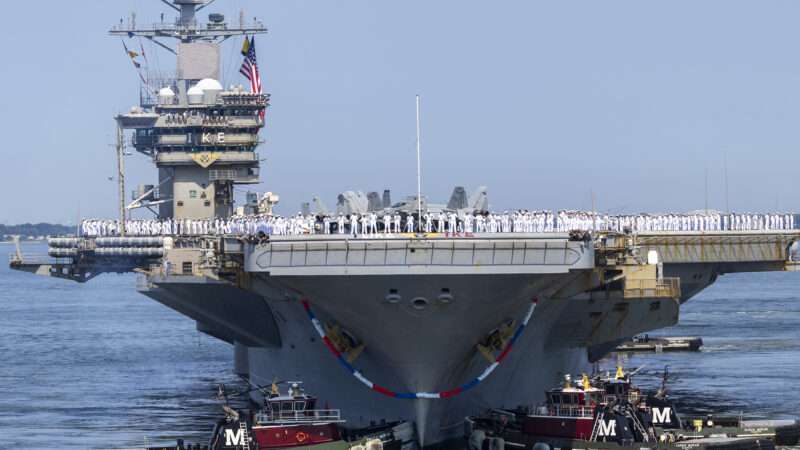
War is not cheap, especially not the past year of Middle Eastern wars. While Israelis, Palestinians, Lebanese, and others pay with their lives by the tens of thousands, Americans are paying much of the financial cost of keeping the violence going.
A new study by the Costs of War Project at Brown University pinned down exactly what that cost is: at least $22.76 billion from October 7, 2023, to September 30, 2024. The bulk of the money, $17.9 billion, was spent on U.S. aid to the Israeli military—both financial grants given to Israel to purchase weapons, and the cost of replacing munitions such as artillery shells sent directly from American stockpiles to the Israeli army.
"The United States can walk and chew gum at the same time, Secretary of Defense Lloyd Austin told reporters on October 13, 2023. "U.S. security assistance to Israel will flow in at the speed of war."
But the U.S. military itself has also burned through expensive ammunition dealing with the spillover of the war into Yemen, Syria, and Iraq.
The study only counts the direct burden on the U.S. military budget. It doesn't include indirect costs, "such as increased U.S. security assistance to Egypt, Saudi Arabia or any other countries, and costs to the commercial airline industry and to U.S. consumers." Nor does it count the $1 billion in U.S. humanitarian aid to Palestinians.
And the study's time frame doesn't include the ongoing Israeli ground invasion of Lebanon, which prompted even more U.S. military deployments to the region, or Iran's October 1 missile attack on Israeli military bases. During the latter incident, the U.S. Navy says it fired "about a dozen interceptors" at the Iranian missiles. "Assuming they were SM-3 interceptors, that represents the production run for an entire year, at a cost of about $400 million total," Middlebury Institute professor Jeffrey Lewis noted on social media.
It cost Israel and its allies $1.3 billion to shoot down a previous Iranian missile barrage in April 2024, retired Brig. Gen. Reem Aminoach told Bloomberg at the time. Soon after the April clashes, Congress budgeted another $5.2 billion for Israeli missile defense.
Last year, the U.S. military also burned through a year's worth of Tomahawk cruise missiles. Soon after the war in Gaza began, the Houthi movement of Yemen declared its solidarity with the Palestinian cause and began attacking international shipping. The U.S. Navy launched a campaign against the Houthis, firing 80 cruise missiles, more than it had purchased the year before, on the first night.
"Are [the airstrikes] stopping the Houthis? No," President Joe Biden told reporters at the time. "Are they going to continue? Yes."
Along with the missile defense aid, the April aid package included another $2.4 billion for U.S. military operations in the Middle East, including the deployment of two aircraft carriers to protect Israel from Iran. (One of the carriers has since returned home.) However, due to the daily costs of operating the aircraft carriers, "the U.S. is on pace to spend at least double the $2.4 billion already appropriated for regional defense," the study estimates.
The United States has also bombed Iraqi militias to prevent them from launching drones—it's unclear whether the target was Israel or U.S. bases—and clashed with those militias in Syria and Jordan.
Former president Donald Trump, meanwhile, has repeatedly argued that the Biden administration isn't supportive enough of Israel's war effort. "I did more for Israel than anybody," he bragged on Monday, two days after he backed a direct attack on Iran. "Israel will cease to exist in two years" if Vice President Kamala Harris is elected, Trump warned last month.
Israel, of course, is happy to take aid whether it comes from a Republican or Democratic administration. In December 2023, staff at the U.S. State Department's weapons export bureau were surprised to encounter an "unusual" thank you gift, ProPublica reported. The Israeli embassy had sent the officials cases of fancy wine with personalized notes.
The wars have also been a huge taxpayer subsidy to American arms manufacturers, the Brown University study adds. And those manufacturers have certainly noticed. In October 2023, the Guardian and Responsible Statecraft reported on a series of "unusually blunt" earnings calls discussing the impact of the war on shareholders.
"Hamas has created additional demand, we have this $106 billion request from the president," an investment analyst said at a weapons company's October 25 call, referring to the Biden administration's aid proposal for Israel and Ukraine at the time. He asked where the company was seeing the most demand.
"You know, the Israel situation obviously is a terrible one, frankly, and one that's just evolving as we speak," a weapons company executive responded. "But I think if you look at the incremental demand potential coming out of that, the biggest one to highlight and that really sticks out is probably on the artillery side."
The post A Year of War in the Middle East Cost Americans Nearly $23 Billion appeared first on Reason.com.







